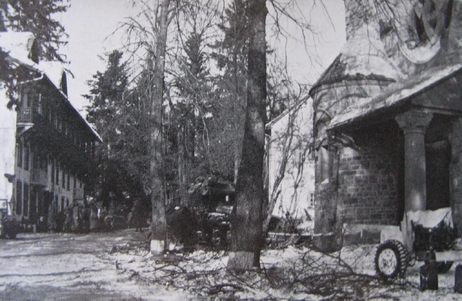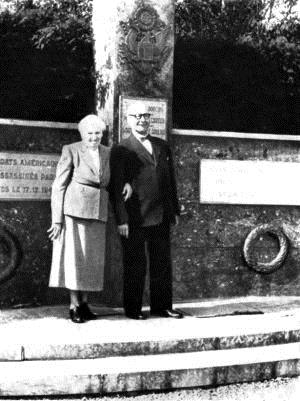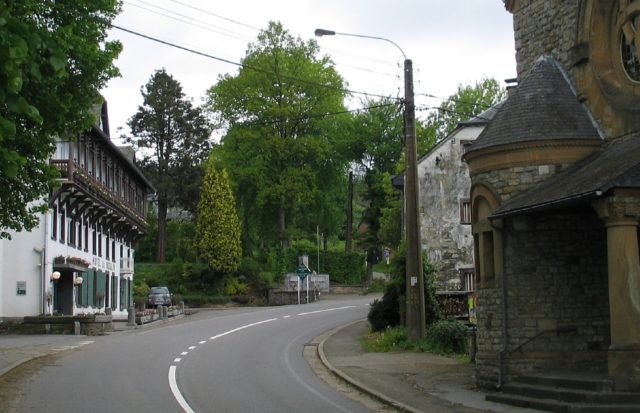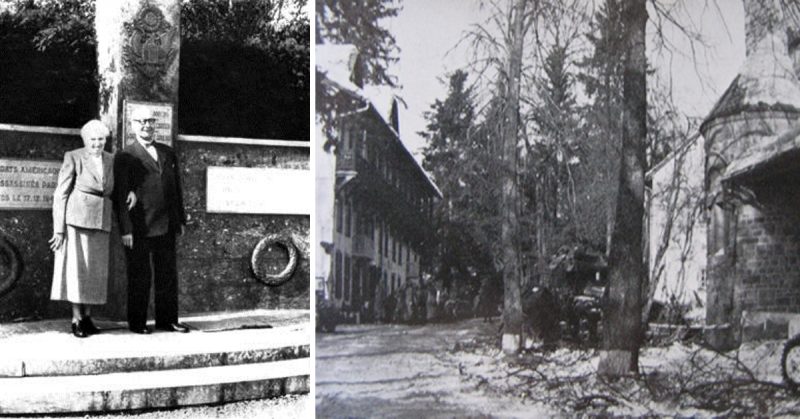Twenty-four hours after the start of the Battle of the Bulge, a horrific chain of events began to unfold in the tiny Belgian town of Lignieuville. At the time, unknown to his family, Peter Rupp, a local hotelier, was an ardent member of the secret Belgian White Army. Hotel du Moulin had long been a “station” in the “underground railroad” network. Using the nom de guerre “Monsieur Kramer”, Peter had hidden allied airmen in a vacant room, until it was safe for to pass them on to the next recipient. In all, twenty-two American, British and French airmen owed their lives to “Monsieur Kramer” who made sure his “guests” were always warm and well fed. Of the many narrow scrapes Peter experienced during the long four years of Nazi occupation, perhaps the closest came albeit unwittingly from his budget-minded wife Balbina when she called in the Gestapo to solve the mystery of why much of the hotel’s food stores were disappearing? Miraculously without ever revealing the truth, Rupp using every ounce of his persuasive power managed to get the investigation called off.
On December 17, 1944, anxiously from one of the hotel’s kitchen windows Rupp looked on as eight American stragglers were forced marched by a German NCO into the yard at the front of the building. Using an automatic pistol the SS sergeant then started, one by one, to execute the helpless prisoners. Rushing to the rear of the building, Rupp shouted to another German sergeant that American prisoners were out front being murdered but these German troops showed no interest in what Rupp was trying to say…no one cared or seemed to give a damn.
Walking to church the following morning, Peter and his family noticed a long line of American tanks and trucks roaring down the hill. Afterwards while making their way home, the dust clouds and petrol fumes began to dissipate as last armored vehicles rumbled passed. A few miles further to the north, Peter could now hear a distant rumble coming from the direction of Malmédy.
The last troops to leave Lignieuville were all from 49th Anti-Aircraft Battalion who pulled out under a tidal wave of panic. As the 450 soldiers were withdrawing a bulldozer came roaring down the hill from the direction of Baugnez and the driver was heard to shout “German tanks – German tanks” by Captain Seymour Green of Service Company 27th Armored Infantry Battalion, 9th Armored Division, who was standing close to the Hotel du Moulin. Just as the first of Captain Green’s service trucks started rolling southward out of the village, an enemy tank came charging down on Lignieuville.

For a short period a single Sherman tank positioned outside the hotel, managed to hold the back the enemy until it was knocked out by a direct hit from an 88. Soon the rest of Joachim Peiper’s First SS Panzer Division Leibstandarte Adolf Hitler poured down the hill from Malmédy. Enraged by the unexpected delay, the SS men leaped impatiently from their vehicles and burst into the hotel.
While Rupp was still protesting the previous days’ butchery, fourteen more American prisoners were herded into the hotel’s lobby – escorted by the very same burly SS sergeant. With complete disregard for his own safety, Rupp strode up to the German NCO shouting “Murderer!”
The SS man took a step back and punched Rupp full in the face, knocking out two teeth. “I know you mean to shoot these men, too” spluttered Rupp now covered in blood, “but you can’t! They’re prisoners of war and should be treated as such”. At that moment a staff officer approached and ordered, “Shoot them all…but shoot that noisy Belgian swine first!” Just then a voice boomed out from behind…”Leave them alone, sergeant.” An officer wearing SS insignia appeared from one of the hotel rooms selected as a command post.
Looking scornfully at the other officer and pointing at a nearby empty room he continued, “Sergeant, put these men in that room over there and treat them as you’d want the Amis to treat you…is that clear?” And so the fourteen American servicemen were crowded into the designated room.
Back in the kitchen, Rupp was worrying about “his fourteen Sammys.” If one small thing went awry, then the murdering might start again. Suddenly an idea erupted. He had hundreds of bottles of the finest cognac and champagne in a secret wine cellar. He’d use them to keep the Germans happy. Creeping down into the cellar, Peter filled his arms with bottles and returned to the kitchen.
“Maria,” he told his daughter, “Give the guard a good cognac so I can talk to the Americans.” Without question, she left the room. A moment later Rupp went to the prisoner’s and held out two bottles. One of the prisoners was Captain Seymour Green who suspiciously inquired, “Just a minute, are you Belgian or German?” “Belgian, of course,” Peter responded while a GI hid the bottles.
“Thanks for the cognac,” Green said, “but we’re hungry.”
Rupp left the room and returned with eight plates on a tray. On his way back with six more meals a suspicious SS officer stopped him.
“What’s the idea?”
“Well, you’re not feeding them, so I have to” replied Peter.
At that moment Rupp’s wife Balbina walked in and overheard the conversation… Balbina who was Swiss born told the German officer, who had no clue she was related to Peter, “See here,” she said, looking at the officer, “I’m from the Swiss Red Cross. I have orders to look after all prisoners, and they get that food!”

The German relented and waived the hotel owner on. Rupp face beaming, hurried in to the prisoners while his wife continued haranguing the SS officer. With the meals delivered, he then stood guard in the lobby surreptitiously handing out bottle after bottle of cognac to the Germans, regardless of rank. The atmosphere grew cordial then jovial.
Midnight passed.
The CP was in constant turmoil as reinforcements kept pouring into the village. A courier returned from Peiper’s spearhead now five miles deeper into Belgium. The news was electrifying: at dawn a strike would be made all the way to the Meuse River. Excitement rose. As the perfect host, Peter Rupp made trip after trip to the secret wine cellar while the Germans drank toasts to the Fuehrer, ate heartily, sang songs of the Homeland and completely forgot about the prisoners.
At 5 A.M. all was quiet except for snoring and the faint chatter of a radio in the command post. Nodding from exhaustion, Peter handed over guard duty to his wife and went to bed. The crisis had passed, the Americans would live.
On December 20, Captain Green and the others were moved to Germany.
Later, during a friendly artillery barrage, Rupp was seriously wounded and was taken to an Army Hospital in St Hubert. When Balbina visited her husband, she asked “What’s this?” as she handed him a very official looking document that had been delivered to the now ruined inn. It was a certificate from Air Chief Marshall Sir Arthur Tedder, honoring Rupp for helping save twenty-two Allied airmen “What is this?” Peter repeated with a grin. “Why it’s for me – the thief who kept stealing our food!”

After the war, Mr. Rupp took it upon himself to fund a monument to the prisoners who died outside his hotel during the Battle of the Bulge. Although some of the money was raised from local donations, Peter personally gifted a sizeable amount to complete the project. But like all true heroes Peter Rupp wanted no recognition for himself and today just to the right of the Hotel du Moulin (which Rupp rebuilt) stands the simple but impressive marker to those eight young Americans who were murdered on December 17, 1944.
By Reg Jans, you can tour with Reg to see key places in our WWII history – check out his website here www.regjans.com
Reg Jans’ deep passion for WWII began as a boy after talking to his grandfather (who had been wounded in 1940 while fighting in France with the Belgian Army) and watching moving picture footage of the D-Day landings, parachute drops over the Netherlands and snow-covered foxholes in the Ardennes. His grandfather’s death signalled a turning point for Reg, along with the realisation that freedom does not come for free and historical knowledge should be preserved and passed on.
Photos courtesy of Reg Jans
